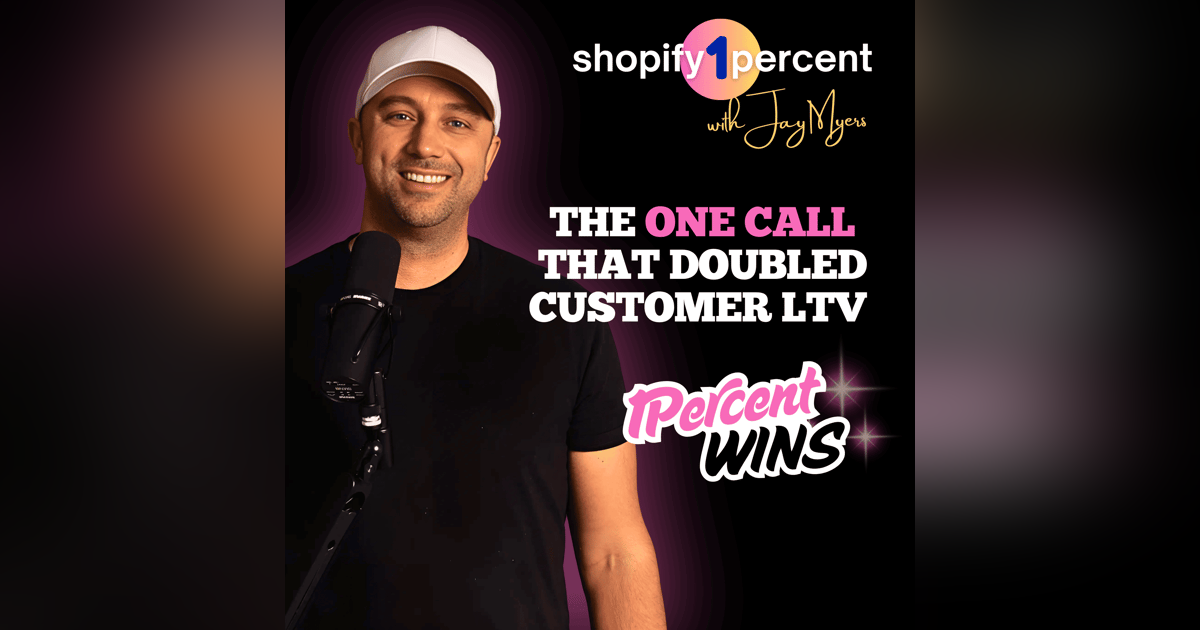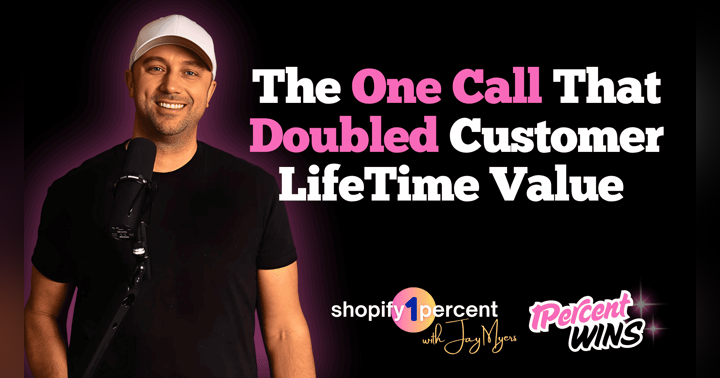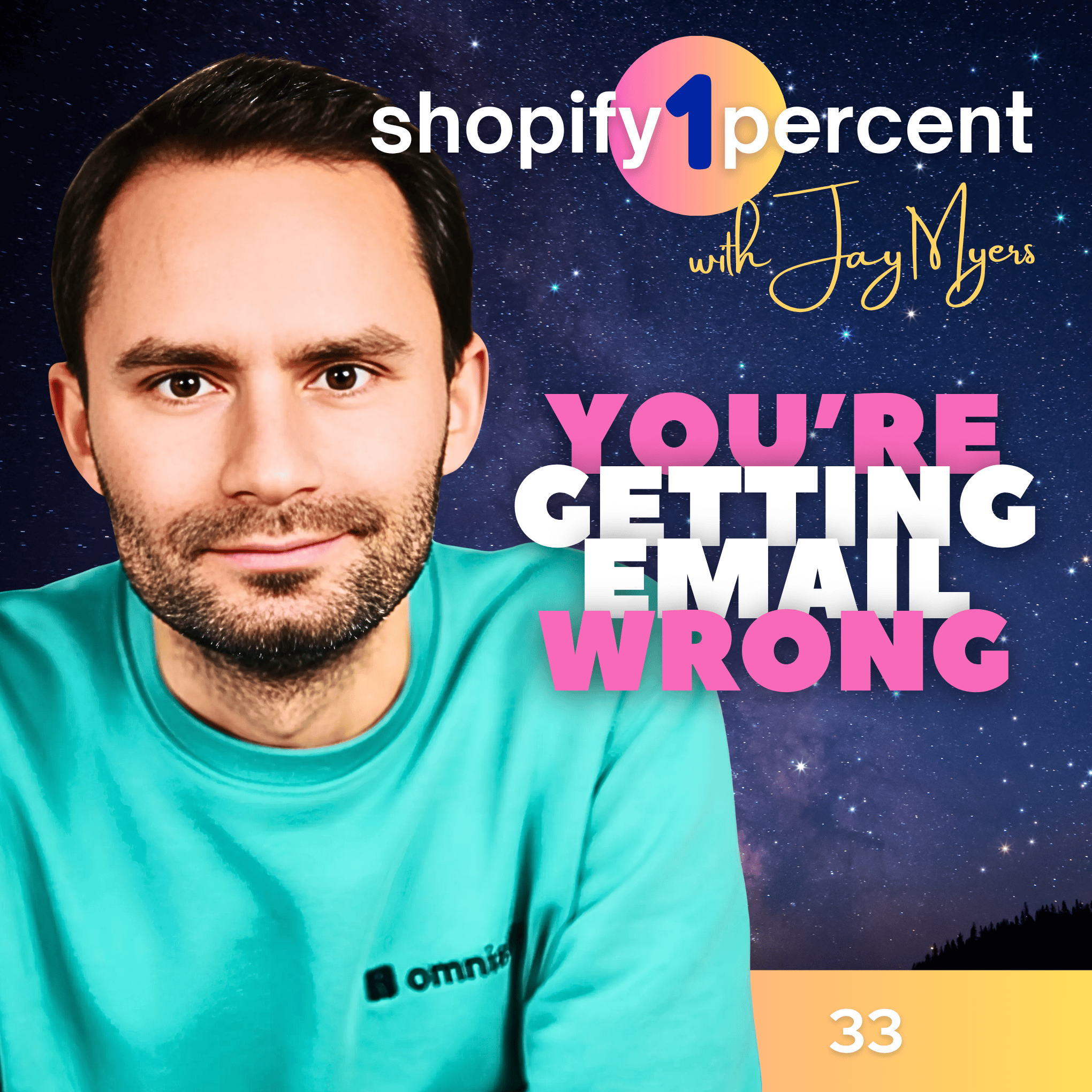🏆 SHOPIFY 1% WINS: One Phone Call That Doubled Our Customer Lifetime Value


What if one simple phone call could double your Shopify customer lifetime value?
In this episode of the Shopify1Percent podcast, I break down a surprising data point we uncovered at Bold: customers who talk to someone from your company are up to 2X more likely to become loyal, repeat buyers. Whether it’s post-purchase onboarding, feature education, or just a friendly check-in, this small human touch could be your biggest Shopify retention hack.
What if one simple phone call could double your Shopify customer lifetime value?
In this episode of the Shopify1Percent podcast, I break down a surprising data point we uncovered at Bold: customers who talk to someone from your company are up to 2X more likely to become loyal, repeat buyers. Whether it’s post-purchase onboarding, feature education, or just a friendly check-in, this small human touch could be your biggest Shopify retention hack.
Key Take-aways
📞 A single phone call post-purchase can double activation rates
💬 Human interaction builds trust, boosts LTV, and increases review rates
🔥 Don’t call them customers until they buy twice — treat them like leads until then
📦 Set up simple filters in your Shopify dashboard to track who to call
🎯 Even a bad support call can drive higher retention than no call at all
🫶 Please support the amazing sponsors that make this show possible. They support us, so we should support them 🫶
Omnisend - I personally use Omnisend for every Shopify store I manage! I’ve tried them all and Omnisend is hands down the easiest way to set up email and sms automations and campaigns, leverage segmentation to personalize them, and A/B test everything to optimize conversion. The push notifications and gamified email collection tools are just the icing on the cake 🤌
(plus most report paying about half the price of Klaviyo 🤫)
*****
🚨Listeners (YOU) get an exclusive 30% OFF for 3 MONTHS: https://shopify1percent.com/omnisend
Bold Commerce - Maximize your Shopify sales with Bold's suite of powerful apps. From AI Upselling, to powerful Subscriptions, Memberships, and VIP Pricing tools, Bold has everything you need to Maximize your Shopify revenue!
Try Bold apps for free here: shopify1percent.com/bold
Did you know leaving a ⭐️⭐️⭐️⭐️⭐️ review on Spotify, or Apple will give your shop gooood ecommerce karma? ❤️
Hey friends. Welcome to another Shopify 1% Daily, short and daily. Shorts are short, seven to 10, max 15 minute. I don't think we'll go that long today. Episodes just with kind of a thought or a tip to help you grow your Shopify business. Hopefully make it 1% better, which is the whole purpose of the show, to improve 1% every day so that the end of the year you're 37 times better. That is the reason why we started this show and why it's called the Shopify 1% podcast. I was at SubSummit down in Dallas last week and I was on a panel for a podcast and something was interesting, like going around SubSummit, I heard a lot of people saying like, oh, I have a thousand subscribers. I have 10,000 subscribers or you know, different things along those lines. And it really, the thing I wanna say is you don't have a subscriber or a customer just because someone buys something off your store. And I think we need to change the language that we're using around that.
And what I mean by that is if someone buys a product, they're not necessarily a customer because they might just be trying your product. They might not be bought in, but they're trying it. A customer is someone who, and yes, people can loosely define it different ways, but in my opinion, a customer is someone who is bought into your brand, believes in your product, has used it more than once, and continues to buy it.
Now that whether they are repeat purchasers or subscribers, but they are. Customer, someone who just finds your site, sees an Instagram ad, maybe finds it through a Google search and goes, okay, it looks interesting, I'll try it. They're not a customer yet. They're just someone trying it and paying some money to try your product.
So I think we need to stop calling them customers and we need to call them "leads". And I said this at SubSummit. I said, stop calling your subscribers "subscribers", call them leads. Because really what someone's doing when they subscribe or even when they buy a product one time is they wanna try it and now your job is to turn them into customers through great onboarding through.
And we talked about that in actually, I don't know if that daily short is out yet, but we talked about the whole onboarding process and you know, don't just send an onboarding email. You could email them three times. The first day you could email them. Literally, the moment they place the order two hours later, four hours later, six hours later, that first day, you can actually get away with three or four emails because they're excited about the product.
Right? So. Um, and then they should get an email every single day until they, until they get the product. So they're educated about about it. They understand the value. They know your company, they know how it's made. You've sent some emails with behind the scenes, just everything so that they are learning and becoming a customer.
Now, when they try the product, they're educated on it, and then they become a customer, I think when they make the second purchase. Now I'm a customer. I've tried it. And so stop celebrating your sales, and these one-time customers. I mean, it's good. You need 'em, you need the conversion, but your metric really should be repeat orders.
Like those reorders are really validation that you've turned a window shopper, someone who's trying it into an actual customer. Now there's a lot of ways you can do this. And there's a lot of data that shows how retention, and we could call it activation, like you're activating 'em to customer.
I'll list maybe two or three things 'cause I, I could talk about this for a while, but I just wanna keep it short. But one thing is feature usage. And so we know that the more a customer understands about a product, the more features of it they use, the longer they will stay and more likely to become a, a lifelong customer.
And so I'm not talking about software features here. This literally can be anything. Let's say you sell a candle, I don't know, but. Maybe the candle the jar or the glass that it comes in can also be a flower vase. Maybe the candle, I don't know. There's different features of the candle, different things that they need to know about the wax.
Like the more they use of a product, the deeper and longer of a better customer they will become. Feature, understanding and usage is a big one. Another thing that we've seen make a massive impact in activation. So activation being they've become a customer, not just a lead. Is talking to someone at your company.
This is mind blowing. We've actually been looking at the data for both the last six months for us at Bold and, when someone talks to someone on our support team, at least once their activation generally doubles. In some of the apps it's even more, it generally doubles and so it not even necessarily, it doesn't have to be like a happy interaction.
It could be that maybe someone used a product and had had trouble with it or couldn't figure it out. So we're not tracking whether it's like a, a positive or negative interaction, just any interaction with our support team. Roughly doubles. So some of, some of them, it went from 23% to 78%. Some of them it went from 42% to 61%.
It varied on, on different products, but roughly it doubled the activation. And so think about ways that you can get in touch with your customers. And so, 'cause a lot of customers, they just, they aren't gonna reach out. Right. So like if they don't, if they don't message you or call you, well, then, we know that their activation to becoming a customer is gonna be less. So could you have a one week check-in call? Like you can do this now with ai even too, like you can have auto dialers and there's some really, really good AI tools that you can train on your, on your products and your knowledge base.
And it legit sounds like you're talking to a person. I don't know if I fully recommend going that route yet, but knowing that. It makes such a big impact. I actually think, there's enough value there that it's worth actually having a person do it. I would experiment with this. I would experiment with a cohort of customers,
if you know your products on average are always at your customer within five days, schedule a call. This would be very easy to do. You literally could go in your Shopify admin and look at all orders that are plus five days since being shipped. You can create a filter. You can go in the top of the in the order panel where you see all your orders.
You can create a filter there that you can only see orders past a certain period. And so whatever your time length is, find all those orders. Call each one. Uh, literally pick up the phone and call them. And then just say, Hey, this is Jay calling from Jay's candles. I wanted just to check in. Did it arrive there safe?
How is it? Did the smell what you wanted? By the way, did you know that we found these three other uses for candle wax that's kind of interesting. I thought I would share with you. That, uh, we're seeing some people. Use the candle wax, I don't, can't think of a good use right now, on hockey sticks, my son uses wax on his hockey stick on snowboards for, to make, to wax them.
I don't know, whatever. Uh, you can share any information, but the point is, is that you're talking to them and just call 'em, just say, Hey, I have no agenda for this call. I just wanted to check in, make sure it arrived safe. Check if you had any questions and let you know that we're here for you. If all is good,
then that's it. If you have any questions, I'm here. But that one interaction will roughly double the activation. And by activation I mean a customer going from a one time testing the product to a lifelong customer. And so then what I would do is every single time I called someone. I will tag them.
And so you go in Shopify, you go in the orders, and I, let's say I'm calling John, I see John ordered this candle. I see his phone number. I call John. And if I get John on the phone, I add a tag called "Phoned". And once you tag it once, then you can just select the customer tag, not on the order. I would add the tag on the customer.
So if you click on John and Shopify, add the tag on him as the customer. So now I know that I've phoned him and I've talked to him. So like now five months later, I can run a report on the lifetime value, the reorder rate of customers that have the tag "phoned" or a successful phoned. But the point is, it's someone that you've spoken to. And I guarantee you that cohort will have a higher LTV, more repeat orders, and they'll be a better customer.
They'll probably like every other metric you track, if you track how many times someone has referred a friend. All those different points. How, how many customers leave a product review? Man, it's probably the best way to get reviews, by the way. 'cause people review people, they don't review companies. And so while you're on this call, if everything is good, just say, "Hey, no pressure at all, but any chance would you mind leaving a review for the product?" We're really trying to build up our reviews and, and I'll, I'll email you a link right here. And if you could leave a review, that would be amazing. And you know what? I'll, uh, I'll give you a, uh, $10 coupon for your next next order.
Something like that. And again, it's encouraging to reorder, so. There's just so many benefits and I just know that, you know that whatever that salary is or whatever you're paying that virtual assistant or someone in your office to call those people. Will be worth it. I pretty much promise you, uh, the data shows it. But to prove me wrong, tag every customer and run a report on them six months or a year later.
You gotta give it a bit of time because for them to reorder and activate. But run that a report on that cohort. Versus the customers that never speak to someone. And you'll come back to me and leave a review on the Shopify 1% podcast. Leave a five star review and just say Jay was right and I won't rub it in your face, but okay.
That's it for today. Uh, right around the 11 minute mark. That's perfect. Thanks so much for joining me on. Today's daily short. I'm having so much fun doing these. And, uh, legitimately though, you don't have to wait six months to leave a, a positive review if, uh, if you're enjoying the show and if you're getting anything out of it, we are legitimately really trying to get reviews.
So a review would mean a ton. And if you leave a comment in the review we show it on our website, we put it up there on the Shopify1percent.com website. So thanks so much and we'll see you on the next episode.






















